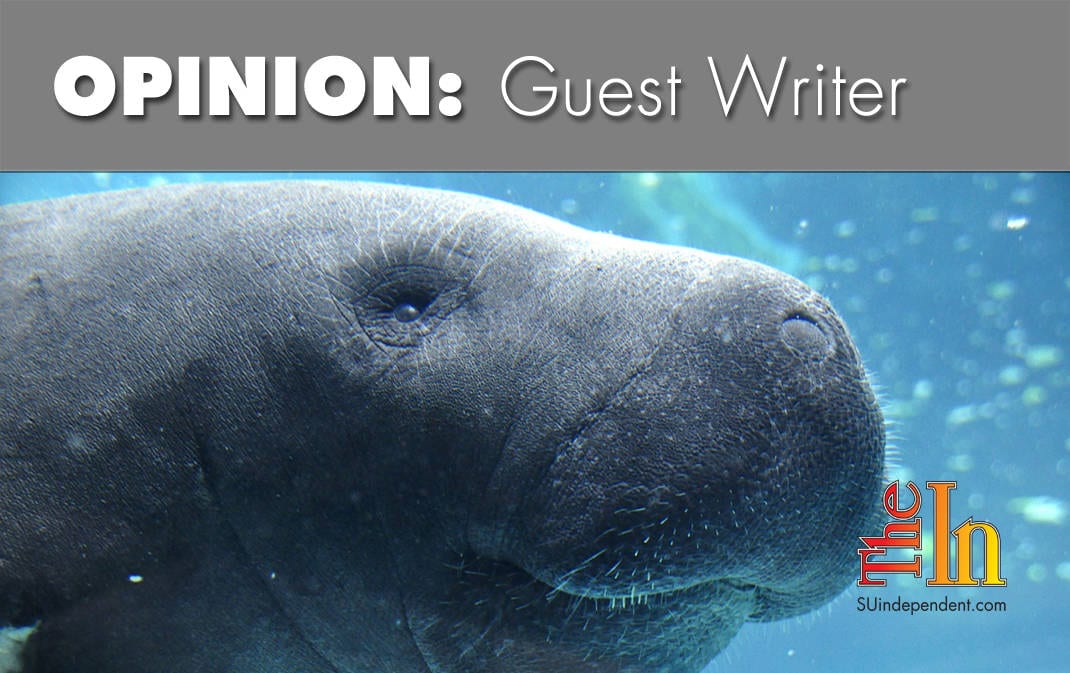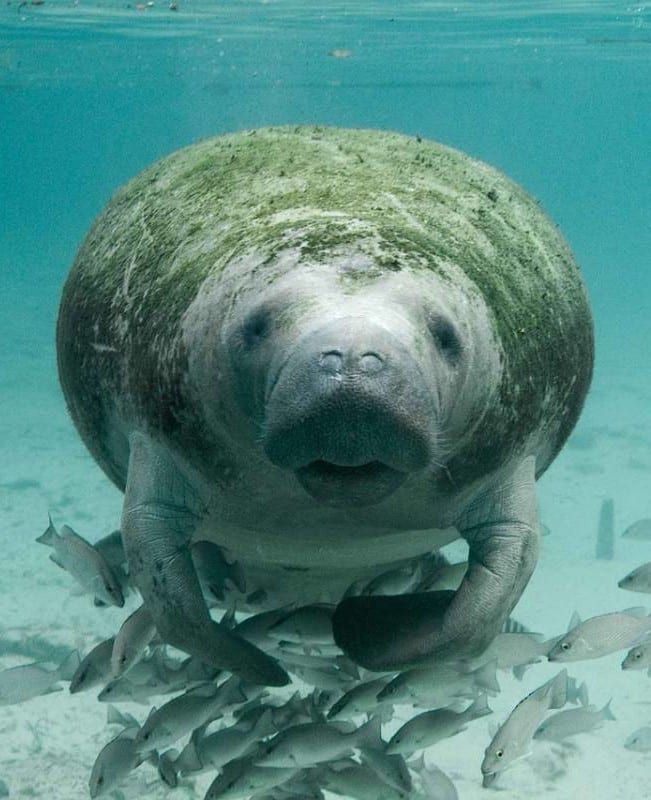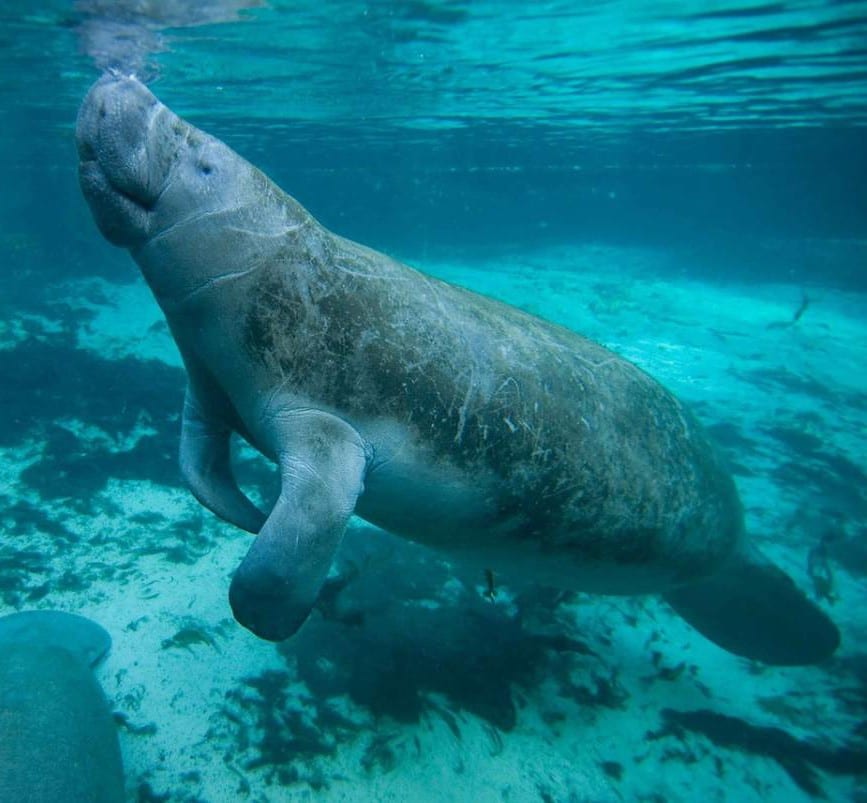 Written by Katie Tripp, Ph.D.
Written by Katie Tripp, Ph.D.
On Jan. 7, the U.S. Fish and Wildlife Service announced plans to downlist all West Indian manatees from endangered to threatened under the Endangered Species Act.
Given the political inconveniences of manatee protection in the U.S., the move to downlist Florida manatees was expected. However, the decision to include the whole species is surprising since there are about as many manatees in the entire rest of the range (Greater Antilles, Mexico, Central America, and South America) as there are in Florida, and “population trends are declining or unknown in 84 percent of the countries where manatees are found,” according to Fish and Wildlife.
Fish and Wildlife’s announcement came at an interesting time in Florida. In December, Florida’s human population surpassed 20 million, a seagrass die-off affecting 40,000 acres in Florida Bay made the news, and the National Marine Manufacturers Association reported that boat sales could increase by 8 percent in 2016, reaching pre-recession levels. Red tide blooms on Florida’s west coast began in the fall, claiming manatee lives in the final weeks of 2015 and continuing to do so in 2016. When questioned whether the model used for the U.S. manatee population included record mortality events from 2010 and 2013, Fish and Wildlife indicated that analysis was incomplete but that they were moving forward based on available information.
 Fish and Wildlife’s announcement that it believes the risks and threats to manatees are pretty well under control indicates that they’re satisfied with the status quo that leaves manatees dying of boat strikes, poisoned by red tide exposure, and facing loss of winter habitat. The 12-month finding states, “Within the southeastern United States, the potential loss of warm water at power plants and natural, warm-water springs used by wintering manatees is identified as a significant threat.”
Fish and Wildlife’s announcement that it believes the risks and threats to manatees are pretty well under control indicates that they’re satisfied with the status quo that leaves manatees dying of boat strikes, poisoned by red tide exposure, and facing loss of winter habitat. The 12-month finding states, “Within the southeastern United States, the potential loss of warm water at power plants and natural, warm-water springs used by wintering manatees is identified as a significant threat.”
The Core Biological Model, which weighed heavily in the decision-making, “predicts that it is unlikely (<2.5 percent chance) that the southeastern U.S. population will fall below 4,000 total individuals over the next 100 years, assuming current threats remain constant indefinitely.” But we know that the threats won’t remain constant. They’ll increase as more than 60 percent of the manatee population is affected by the “pending” loss of artificial warm water. There are no plans yet developed to determine how to replace lost warm-water habitat, how to get manatees to transition to new sites, or how to minimize negative impacts to the manatee population in the process.
Recovery is about much more than just species abundance. While Fish and Wildlife officials acknowledged that population numbers aren’t always the best way to approach recovery, they seem comfortable in using them to justify downlisting. And what about the pent-up coastal development that is about to burst with the recovering economy? The agencies are not prepared to prevent or offset these cumulative effects. In a 2010 Fish and Wildlife report on warm-water habitat, the agency stated, “Implementation of management decisions is very much influenced by stakeholder values and public perception of manatee status and protection from threats.” How will Fish and Wildlife garner the public and financial support needed to recover manatees if the public thinks the manatees’ future is “rosy”?
Fish and Wildlife says protections for manatees won’t change with downlisting. That’s not comforting since some big changes are needed to get the manatees’ habitat secured for the future. Unfortunately, the agencies will be lucky if they can manage to hang on to existing protections in the years to come. The Tampa Tribune reported one manatee foe’s beliefs: “… there is no longer a need for widespread boating restrictions. …” or “… sanctuaries in which vessels are prohibited. …” Another group’s website states that downlisting, “may also prevent additional unnecessary regulations and reduce the need for some existing ones. …”
 The latest anti-manatee tactic is to paint them as destroyers of the environment, making statements including, “If we can’t do anything to manage the size and location of the herd, we are doomed to sit back and hope the manatee does not over pressure the SAV (submerged aquatic vegetation). …” These same folks are trying to get legislation sponsored in Tallahassee that would destroy the Florida Manatee Sanctuary Act and are lobbying for rules to allow the legal take (read: killing) of manatees.
The latest anti-manatee tactic is to paint them as destroyers of the environment, making statements including, “If we can’t do anything to manage the size and location of the herd, we are doomed to sit back and hope the manatee does not over pressure the SAV (submerged aquatic vegetation). …” These same folks are trying to get legislation sponsored in Tallahassee that would destroy the Florida Manatee Sanctuary Act and are lobbying for rules to allow the legal take (read: killing) of manatees.
One Fish and Wildlife official at their press conference explained that if they didn’t reclassify manatees to threatened, they would show no progress. That’s really what this is about. The Endangered Species Act has enemies, and if the agencies don’t show movement, they come under fire. The agency’s director is quoted as saying that he sees a “giant clash” between those who favor conservation and those who favor economic development and believes conservationists “must accept a world with fewer wolves, salmon, and spotted owls,” and apparently manatees.
Save the Manatee Club has been working for almost 35 years towards a day when manatees can be downlisted and ultimately delisted from the Endangered Species Act, but the manatees’ future is far from certain, which means the work is far from over.
Dr. Katie Tripp has been Save the Manatee Club’s director of science and conservation since May 2008. She received her Ph.D. in veterinary medical sciences from the University of Florida where she conducted research on manatee physiology.



